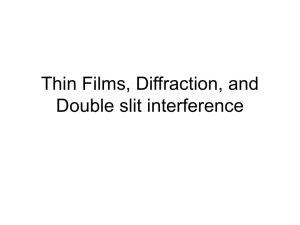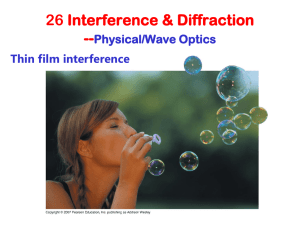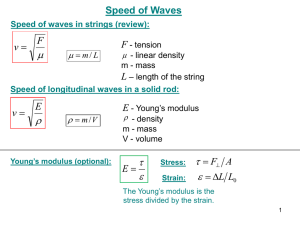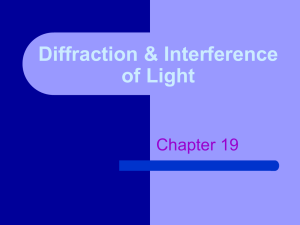solution
advertisement
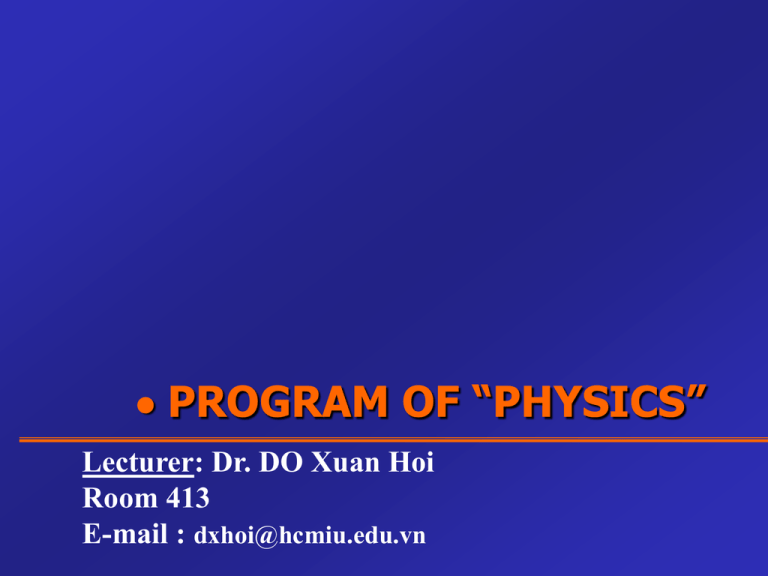
PROGRAM OF “PHYSICS” Lecturer: Dr. DO Xuan Hoi Room 413 E-mail : dxhoi@hcmiu.edu.vn PHYSICS 4 (Wave and Modern Physics) 02 credits (30 periods) Chapter 1 Mechanical Wave Chapter 2 Properties of Light Chapter 3 Introduction to Quantum Physics Chapter 4 Atomic Physics Chapter 5 Relativity and Nuclear Physics References : Halliday D., Resnick R. and Walker, J. (2005), Fundamentals of Physics, Extended seventh edition. John Willey and Sons, Inc. Alonso M. and Finn E.J. (1992). Physics, AddisonWesley Publishing Company Hecht, E. (2000). Physics. Calculus, Second Edition. Brooks/Cole. Faughn/Serway (2006), Serway’s College Physics, Brooks/Cole. Roger Muncaster (1994), A-Level Physics, Stanley Thornes. http://ocw.mit.edu/OcwWeb/Physics/index.htm http://www.opensourcephysics.org/index.html http://hyperphysics.phyastr.gsu.edu/hbase/HFrame.html http://www.practicalphysics.org/go/Default.ht ml http://www.msm.cam.ac.uk/ http://www.iop.org/index.html . . . PHYSICS 4 Chapter 2 Properties of Light A. WAVE OPTICS The Nature of Light Interference of Light Waves Diffraction Patterns Polarization B. GEOMETRIC OPTICS Light Rays The Laws of Reflection and Refraction Mirrors Thin Lenses A. WAVE OPTICS The Nature of Light Interference of Light Waves Diffraction Patterns Polarization 1 The Nature of Light 1.1 Dual nature of light • In some cases light behaves like a wave (classical E & M – light propagation) • In some cases light behaves like a particle (photoelectric effect) • Einstein formulated theory of light: E hf h 6.63 10 34 J s Planck’s constant 1.2 Huygens’s Principle Light travels at 3.00 x 108 m/s in vacuum (travels slower in liquids and solids) In order to describe propagation: Huygens method : All points on given wave front taken as point sources for propagation of spherical waves Assume wave moves through medium in straight line in direction of rays 2 Interference of Light Waves 2.1 Conditions for interference light sources must be coherent (must maintain a constant phase with each other) sources must have identical wavelength superposition principle must apply 2.2 Young’s Double-Slit Experiment • Setup: light shines at the plane with two slits • Result: a series of parallel dark and bright bands called fringes In phases Opposite phases Interference of Sinusoidal Waves y 1 A sin(t Kd 1 ) ; y 2 A sin(t Kd 2 ) ; K y y1 y 2 A sin(t Kd 1 ) A sin(t Kd 2 ) 2 A sin(t Kd1 ) sin(t Kd 2 ) d1 d 2 d d1 2A cos K 2 sin( t K ) 2 2 Amplitude of y depends on the path difference : = d2 - d1 Amplitude of y maximum : M d 2 d1 d d1 K k ; cos K 2 1 ; 2 2 2k d 2 d1 ; d 2 d1 k 2 / Amplitude of y equal to 0 : d1 S1 1 d 2 d1 (k ) 2 d2 S2 The path difference in Young’s Double-Slit Experiment d1 d2 d 2 d1 d sin d tan y d L Positions of fringes on the screen d sin Bright fringes (constructive interference) : d L y BRIGHT k ; y BRIGHT k ki L d Dark fringes (destructive interference) : 1 d 1 y DARK (k ) ; y DARK k i 2 L 2 L i d Angular Positions of Fringes y d L Bright regions (constructive interference) : d sin k Dark regions (destructive interference) : 1 d sin (k ) 2 PROBLEM 1 A viewing screen is separated from a doublelit source by 1.2 m. The distance between the two slits is 0.030 mm. The second-order bright fringe is 4.5 cm from the center line. (a) Determine the wavelength of the light. SOLUTION (a) The position of second-order bright fringe : L L y2 k 2 d d dy 2 (3.0 105 m )(4.5 10 2 m ) 2L 2(1.2 m ) 5.6 107 m 560 nm PROBLEM 1 A viewing screen is separated from a doublelit source by 1.2 m. The distance between the two slits is 0.030 mm. The second-order bright fringe is 4.5 cm from the center line. (b) Calculate the distance between adjacent bright fringes. SOLUTION L L L (b) y k 1 y k (k 1) k i d d d L (5.6 107 m )(1.2 m ) i 2.2 cm 5 d 3.0 10 m PROBLEM 2 A light source emits visible light of two wavelengths: 430 nm and 510 nm. The source is used in a double-slit interference experiment in which L = 1.5 m and d = 0.025 mm. Find the separation distance between the third order bright fringes. SOLUTION L (1.5 m )(430 109 m ) 2 y3 3 3 7.74 10 m 3 0.025 10 m d L (1.5 m )(510 109 m ) 2 y 3' 3 ' 3 9.18 10 m 3 0.025 10 m d y y 3' y 3 9.18 102 m 7.74 102 m 1.40 102 m 1.40 cm PROBLEM 3 SOLUTION 2.3 Intensity distribution of the double-slit. Interference pattern light : electromagnetic wave • suppose that the two slits represent coherent sources of sinusoidal waves : the two waves from the slits have the same angular frequency • assume that the two waves have the same amplitude E0 of the electric field at point P d1 d2 At point P : E 1 E 0 sin(t Kd1 ) ; E 2 E 0 sin(t Kd 2 ) ; K 2 d1 d 2 d 2 d1 E E 1 E 2 2E 0 cos K sin(t K ) 2 2 d d Amplitude of E : 2E 0 cos K 2 1 2E 0 cos K 2 2 d1 d2 At point P : d 2 d 1 2E cos K Amplitude of E : 2E 0 cos K 0 2 2 The intensity of a wave is proportional to the square of the electric field magnitude at that point : I I 0 cos 2 K d 2 d1 d sin d sin I I 0 cos 2 y sin tan ; L dy I I 0 cos L 2 2 2 d sin I I 0 cos 2 2 The intensity maximum : dy d sin n n ; L L sin n ; y n d d d1 d2 PROBLEM 4 SOLUTION PROBLEM 4 SOLUTION I PROBLEM 4 SOLUTION PROBLEM 4 SOLUTION I 2.4 INTERFERENCE IN THIN FILMS • Interference effects are commonly observed in thin films, such as thin layers of oil on water or the thin surface of a soap bubble • The varied colors observed when white light is incident on such films result from the interference of waves reflected from the two surfaces of the film a. Change of phase due to reflection Interference pattern with Lloyd’s mirror P’ is equidistant from points S and S : the path difference is zero bright fringe at P’ ? We observe a dark fringe at P’ There a 180° phase change produced by reflection CONCLUSION : an electromagnetic wave undergoes a phase change of 180° upon reflection from a medium that has a higher index of refraction than the one in which the wave is traveling. Change of phase due to reflection 180° phase change No phase change If is the wavelength of the light in free space c f c and if the medium has the refraction index n : n v The wavelength of light in this medium : c v ; n n n f nf b. Interference in thin films • Consider a film of uniform thickness t and index of refraction n. Assume that the light rays traveling in air are nearly normal to the two surfaces of the film. • Reflected ray 1 : phase change of 180° with respect to the incident wave. • Reflected ray 2 : no phase change • Ray 1 is 180° out of phase with ray 2 a path difference of n /2. • ray 2 travels an extra distance 2t before the waves recombine in the air • Ray 1 is 180° out of phase with ray 2 a path difference of n /2. • ray 2 travels an extra distance 2t before the waves recombine in the air Condition for constructive interference : 1 2t (m )n 2 1 (m ) 2 n 1 2nt (m ) 2 Condition for destructive interference : 2nt mn m 0; 1; 2; 3;... PROBLEM 5 Calculate the minimum thickness of a soapbubble (n = 1.33) film that results in constructive interference in the reflected light if the film is illuminated with light whose wavelength in free space is = 600 nm. SOLUTION 1 Constructive interference : 2nt (m ) 2 The minimum film thickness : m = 0 2nt 2 600 nm t 113 nm 4(1.33) 4n PROBLEM 6 A thin, wedge-shaped film of refractive index n is illuminated with monochromatic light of wavelength , as illustrated in the figure. Describe the interference pattern observed for this case. SOLUTION m Dark fringes : 2nt m m ; t m 2n t 0 0 ; t 1 1. ; t 2 2. ;... 2n 2n Bright fringes : 2nt m 3. 5. t0 ; t1 ; t2 ;... 4n 4n 4n 1 (m ) 2 PROBLEM 6 A thin, wedge-shaped film of refractive index n is illuminated with monochromatic light of wavelength , as illustrated in the figure. Describe the interference pattern observed for this case. SOLUTION White light : m Dark fringes : 2nt m m ; t m 2n 1 Bright fringes : 2nt m (m ) 2 PROBLEM 7 Suppose the two glass plates in the figure are two microscope slides 10.0 cm long. At one end they are in contact; at the other end they are separated by a piece of paper 0.0200 mm thick. What is the spacing of the interference fringes seen by reflection? Is the fringe at the line of contact bright or dark? Assume monochromatic light with a wavelength in air of = 500nm. SOLUTION Dark fringes : 2nt 2t m t h m h ; ; x l 2x l l (0.100 m )(500 109 m ) x m m 2(0.002 103 m ) 2h 1.25m (mm ) 0; 1.25 mm ; 2.50 mm ;... PROBLEM 7 Suppose the two glass plates in the figure are two microscope slides 10.0 cm long. At one end they are in contact; at the other end they are separated by a piece of paper 0.0200 mm thick. What is the spacing of the interference fringes seen by reflection? Is the fringe at the line of contact bright or dark? Assume monochromatic light with a wavelength in air of = 500nm. Suppose the glass plates have n = 1.52 and the space between plates contains water (n = 1.33) instead of air. What happens now? SOLUTION In the film of water (n = 1.33), the wavelength : 500 nm ' 376 nm n 1.33 'l l (0.100 m )(500 109 m ) x 'm m m 2(0.002 103 m )(1.33) 2h n 2h 1.25m /1.33 (mm ) 0.0150m (mm ) 0; 0.015 mm ; 0.030 mm ;... PROBLEM 8 Suppose the two glass plates in the figure are two microscope slides 10.0 cm long. At one end they are in contact; at the other end they are separated by a piece of paper 0.0200 mm thick. What is the spacing of the interference fringes seen by reflection? Is the fringe at the line of contact bright or dark? Assume monochromatic light with a wavelength in air of = 500nm. Suppose the upper of the two plates is a plastic material with n = 1.40, the wedge is filled with a silicone grease having n = 1.50, and the bottom plate is a dense flint glass with n = 1.60. What happens now? SOLUTION SOLUTION The wavelength in the silicone grease: 500 nm 333 nm ' 1.50 n The two reflected waves from the line of contact are in phase (they both undergo the same phase shift), so the line of contact is at a bright fringe. x ' 0.833 mm c. Newton’s Rings The convex surface of a lens in contact with a plane glass plate. A thin film of air is formed between the two surfaces. View the setup with monochromatic light : Circular interference fringes Ray 1 : a phase change of 180° upon reflection; ray 2 : no phase change the conditions for constructive and destructive interference 2.5 THE MICHELSON INTERFEROMETER Principle : splits a light beam into two parts and then recombines the parts to form an interference pattern Use : To measure wavelengths or other lengths with great precision The observer sees an interference pattern that results from the difference in path lengths for rays 1 and 2. 3. Light Diffraction 3.1 Introduction If a wave encounters a barrier that has an opening of dimensions similar to the wavelength, the part of the wave that passes through the opening will spread out (diffract) into the region beyond the barrier That is another proof of wave nature Diffraction Phenomenon WAVE Light produces also the diffraction: a light (with appropriate wavelength) beam going through a hole gives a number of circular fringes 3.2 Fraunhofer diffraction All the rays passing through a narrow slit are approximately parallel to one another. Diffraction from narrow slit Huygens’s principle : Each portion of the slit acts as a source of light waves Divide the slit into two halves Rays 1 and 3 : ray 1 travels farther than ray 3 by an amount equal to the path difference (a/2) sin Rays 2 and 4 : ray 2 travels farther than ray 4 by an amount equal to the path difference (a/2) sin Waves from the upper half of the slit interfere destructively with waves from the lower half when : a sin ; sin a 2 2 Divide the slit into two halves a 2 sin 2 a ; sin Divide the slit into four parts : Dark fringes : a sin ; sin 2 a 4 2 Divide the slit into six parts : Dark fringes : a 6 sin 2 ; sin 3 a Divide the slit into two halves : sin a Divide the slit into four parts : Dark fringes : sin 2 a Divide the slit into six parts : Dark fringes : sin 3 a The general condition for destructive interference : sin m a ; a m 1; 2; 3;... ym sin tan L Positions of dark fringes : ym m L ; a m 1; 2; 3;... Light of wavelength 580 nm is incident on a slit having a width of 0.300 mm. The viewing screen is 2.00 m from the slit. Find the positions of the first dark fringes and the width of the central bright fringe. PROBLEM 9 SOLUTION sin m ; a m 1; 2; 3;... The two dark fringes that flank the central bright fringe : m = 1 The width of the central bright fringe : 2 y 1 2(3.87 mm ) 7.74 mm You pass 633-nm laser light through a narrow slit and observe the diffraction pattern on a screen 6.0 m away. You find that the distance on the screen between the centers of the first minima outside the central bright fringe is 32 mm. How wide is the slit? PROBLEM 10 SOLUTION Dark fringes : ym m L ; a m 1; 2; 3;... The first minimum : m = 1 L 32 mm y1 1 a 2 L (6 m )(633 109 m ) a 0.24 mm 3 y1 32 10 m / 2 Intensity of Single-Slit Diffraction Patterns The intensity at each point on the screen : I I max sin( a sin / ) a sin / 2 where Imax is the intensity at = 0 (the central maximum). We see that minima occur when : a sin / m sin m a a sin/ (The general condition for destructive interference) Width of the Single-Slit Pattern a= sin( a sin / ) a sin / 2 I I max First dark fringes : sin 1 a The single-slit diffraction pattern depends on the ratio : a a = : sin = 1 = /2 a = 5 a = 8 Consequence : a >> : sin << 1 0 : We can consider practically all the light to be concentrated at the geometrical focus. a < : /2 : The central maximum spreads over 180o : the fringe pattern is not seen at all. Example : The sound waves in speech : 1 m. Doorway < 1 m : a < The central intensity maximum extends over 180o. The sounds coming through an open doorway or can bend around the head of an instructor. Visible light ( 5 10-7 m), doorway (a 1 m) : << a No diffraction of light; you cannot see around corners PROBLEM 11 Find the ratio of the intensities of the secondary maxima to the intensity of the central maximum for the singleslit Fraunhofer diffraction pattern. SOLUTION To a good approximation, the secondary maxima lie midway between the zero points 2 a sin/ sin( a sin / ) I I max a sin / I1 I max I2 I max 2 This corresponds to a sin/ values of 3/2, 5/2, 7/2, . . . sin(3 / 2) The first secondary maxima (the ones 0.045 adjacent to the central maximum) have (3 / 2) 2 an intensity of 4.5% that of the central sin(5 / 2) 0.016 maximum, and the next secondary (5 / 2) maxima : 1.6% Intensity of Two-Slit Diffraction Patterns Must consider not only diffraction due to the individual slits but also the interference of the waves coming from different slits. The combined effects of diffraction and interference The pattern produced when 650-nm light waves pass through two 3.0-m slits that are 18 m apart 3.3 THE DIFFRACTION GRATING An array of a large number of parallel slits, all with the same width a and spaced equal distances d between centers, is called a diffraction grating The condition for maxima in the interference pattern at the angle : d sin m m 0; 1;2 ;... Use this expression to calculate the wavelength if we know the grating spacing d and the angle PROBLEM 12 The wavelengths of the visible spectrum are approximately 400 nm (violet) to 700 nm (red). Find the angular width of the first-order visible spectrum produced by a plane grating with 600 slits per millimeter when white light falls normally on the grating. SOLUTION The grating spacing : d 1 600 slits / mm 1.67 10 6 m m = 1, the angular deviation of the violet light : 9 V 400 10 m ; 13.90 sin V 1. V 1.67 106 m d The angular deviation of the red light : R 700 109 m 0 24.8 sin R 1. ; R d 1.67 106 m The angular width of the first-order visible spectrum : R V 24.80 13.90 10.90 PROBLEM 13 Monochromatic light from a helium-neon laser ( = 632.8 nm) is incident normally on a diffraction grating containing 6 000 lines per centimeter. Find the angles at which the first order, second-order, and third-order maxima are observed. SOLUTION 1 cm 1667 nm 6000 For the first-order maximum (m = 1) we obtain : The slit separation : d 632.8 nm ; 1 22.310 d 1667 nm For the second-order maximum (m = 2) we find: 632.8 nm sin 2 2. 2 ; 2 49.390 d 1667 nm For m = 3 we find that sin3 > 1 : only zeroth-, first-, and second-order maxima are observed sin 1 1. 3.4 Circular Apertures The diffraction pattern formed by a circular aperture consists of a central bright spot surrounded by a series of bright and dark rings If the aperture diameter is D and the wavelength is , the angular radius 1 of the first , the second dark ring,… are given by : sin 1 1.22 ; sin 2 2.23 D D Between these are bright rings with angular radii given by : sin 1.63 ;2.68 ;... D D (The central bright spot is called the Airy disk) PROBLEM 14 Monochromatic light with wavelength 620 nm passes through a circular aperture with diameter 7.4 m. The resulting diffraction pattern is observed on a screen that is 4.5 m from the aperture. What is the diameter of the Airy disk on the screen? SOLUTION The angular size of the first dark ring : 9 620 10 m sin 1 1.22 1.22 ; 1 0.1022 rad 6 d 7.4 10 m The radius of the Airy disk (central bright spot) : r (4.5 m ) tan 1 0.462 m The diameter : 2r = 0.92 m = 92 cm. 3.5 DIFFRACTION OF X-RAYS BY CRYSTALS X-rays are electromagnetic waves of very short wavelength (of the order of 0.1 nm) How to construct a grating having such a small spacing ? The beam reflected from the lower plane travels farther than the one reflected from the upper plane by a distance 2d sin The diffracted beams are very intense in certain directions constructive interference : Laue pattern Crystalline structure of sodium chloride (NaCl) a 0.56 nm - Cl Na+ PROBLEM 15 You direct a beam of x rays with wavelength 0.154 nm at certain planes of a silicon crystal. As you increase the angle of incidence from zero, you find the first strong interference maximum from these planes when the beam makes an angle of 34.5o with the planes. (a) How far apart are the planes? SOLUTION (a) The Bragg equation : 2d sin m The distance between adjacent planes : (1)(154 nm ) m d 0.136 nm 0 2.sin34.5 2 sin PROBLEM 15 You direct a beam of x rays with wavelength 0.154 nm at certain planes of a silicon crystal. As you increase the angle of incidence from zero, you find the first strong interference maximum from these planes when the beam makes an angle of 34.5o with the planes. (b) Other interference maxima from these planes at larger angles? SOLUTION (a) The Bragg equation : 2d sin m The distance between adjacent planes : (1)(154 nm ) m 0.136 nm 0 2.sin34.5 2 sin 154 nm m m (b) sin 0.566m 2(0.136 nm ) 2d m = 2 : sin > 1 there are no other angles for interference maxima for this particular set of crystal planes. d 4. POLARIZATION OF LIGHT WAVES 4.1 Introduction Light wave is electromagnetic (EM) wave traveling at the speed of light c E B • The E and B fields are perpendicular to each other • Both fields are perpendicular to the direction of motion Therefore, em waves are transverse waves The wavelength of light in the vacuum : c f The EM Spectrum • Note the overlap between types of waves • Visible light is a small portion of the spectrum • Types are distinguished by frequency or wavelength Polarized waves on a string. (a) Transverse wave linearly polarized in the y-direction (b) Transverse wave linearly polarized in the z-direction (c) The slot functions as a polarizing filter, passing only components polarized in the y-direction. 4.2 Polarization of an electromagnetic wave We always define the direction of polarization of an electromagnetic wave to be the direction of the electric-field vector E ; not the magnetic field B The plane formed by E and the direction of propagation is called the plane of polarization of the wave. E Circular polarization may be referred to as right-handed or left-handed, depending on the direction in which the electric field vector rotates A linearly polarized light beam viewed along the direction of propagation (perpendicular to the screen) CAUTION Polarization : 1st meaning : to describe the the shifting of electric charge within a body, such as in response to a nearby charged body 2nd meaning : to describe the direction of E in an electromagnetic wave A symmetric molecule has no permanent polarization An external electric field induces a polarization in the molecule. These two concepts have the same name, they do not describe the same phenomenon 4.3 Polarizing Filters Waves emitted by a radio transmitter are usually linearly polarized. An ordinary beam of light consists of a large number of waves emitted by the atoms of the light source. Each atom produces a particular direction of E All directions of vibration from a wave source are possible, the resultant electromagnetic wave is a superposition of waves vibrating in many different directions. An unpolarized light beam Polarizing Filters : To create polarized light from unpolarized natural light Polarizing Filter The most common polarizing filter for visible light : called Polaroid Polaroid : material is fabricated in thin sheets of long-chain hydrocarbons which transmits 80% or more of the intensity of a wave that is polarized parallel to a certain axis in the material, called the polarizing axis What happens when the linearly polarized light emerging from a polarizer passes through a second polarizer (analyser) ? E 0 cos : angle between the polarizing axes of the polarizer and analizer The intensity of the light transmitted through the analyzer : I I MAX cos2 (Malus’s law) (Imax is the intensity of the polarized beam incident on the analyzer) I I MAX cos2 (Malus’s law) polarizer analyser = 0 ; I = IMAX polarizer analyser = 450 ; I < IMAX polarizer analyser = 900 ; I = 0 PROBLEM 16 If the incident unpolarized light has intensity I0 , find the intensities transmitted by the first and second polarizers if the angle between the axes of the two filters is 30°. SOLUTION This problem involves a polarizer (a polarizing filter on which unpolarized light shines, producing polarized light) and an analyzer (a second polarizing filter on which the polarized light shines). The angle between the polarizing axes : 300 Malus's law : I I MAX cos2 I0 2 0 I 2 cos 30 3 I0 8 I0 I0 2 4.4 Polarization by Reflection Unpolarized light can be polarized, either partially or totally, by reflection. The angle of incidence at which the reflected beam is completely polarized is called the polarizing angle p . (the reflected ray and the refracted ray are perpendicular to each other) Snell’s law of refraction : Brewster’s angle : tan p n A. WAVE OPTICS B. GEOMETRIC OPTICS Light Rays The Laws of Reflection and Refraction Mirrors Thin Lenses 5. Light Rays A wave front is a surface of constant phase; wave fronts move with a speed equal to the propagation speed of the wave. A ray is an imaginary line along the direction of travel of the wave Spherical wave fronts : the rays are the radii of the sphere Planar wave fronts : the rays are straight lines perpendicular to the wave fronts. 6. Reflection and Refraction 6.1 Basic notions When a light wave strikes a smooth interface separating two transparent materials (such as air and glass or water and glass), the wave is in general partly reflected and partly refracted (transmitted) into the second material If the interface is rough, both the transmitted light and the reflected light are scattered in various directions Reflection at a definite angle from a very smooth surface is called specular reflection (from the Latin word for "mirror"); scattered reflection from a rough surface is called diffuse reflection. The directions of the incident, reflected, and refracted rays at a interface between two optical materials in terms of the angles they make with the normal (perpendicular) to the surface at the point of incidence The index of refraction of an optical material (also called the refractive index), denoted by n. n c v (the ratio of the speed of light c in vacuum to the speed v in the material) cv n 1 6.2 The Laws of Reflection and Refraction The incident, reflected, and refracted rays and the normal to the surface all lie in the same plane The angle of reflection is equal to the angle of incidence for all wavelengths and for any pair of materials. a b (law of reflection) For monochromatic light and for a given pair of materials, a and b, on opposite sides of the interface, the ratio of the sins of the angles a and b, is equal to the inverse ratio of the two indexes of refraction: na sinb nb sinb (law of refraction - Snell's law) incident ray na nb normal reflected ray a a b refracted ray PROBLEM 17 In the figure, material a is water and material is a glass with index of refraction 1.52. If the incident ray makes an angle of 600 with the normal, find the directions of the reflected and refracted rays. SOLUTION PROBLEM 18 The wavelength of the red light from a helium-neon laser is 633 m in air but 474 m in the aqueous humor inside your eye-ball. Calculate the index of refraction of the aqueous humor and the speed and frequency of the light in this substance. SOLUTION PROBLEM 19 Light traveling in water strikes a glass plate at an angle of incidence of 53.00; part of the beam is reflected and part is refracted. If the reflected and refracted portions make an angle of 90.00 with each other, what is the index of refraction of the glass? SOLUTION A ray of light traveling with speed c leaves point 1 shown in the figure and is reflected to point 2. The ray strikes the reflecting surface a horizontal distance x from point 1. (a) What is the time t required for the light to travel from 1 to 2 ? (b) When does this time reaches its minimum value ? PROBLEM 20 SOLUTION A ray of light traveling with speed c leaves point 1 shown in the figure and is reflected to point 2. The ray strikes the reflecting surface a horizontal distance x from point 1. (a) What is the time t required for the light to travel from 1 to 2 ? (b) When does this time reaches its minimum value ? PROBLEM 20 SOLUTION A ray of light traveling with speed c leaves point 1 shown in the figure and is reflected to point 2. The ray strikes the reflecting surface a horizontal distance x from point 1. (a) What is the time t required for the light to travel from 1 to 2 ? (b) When does this time reaches its minimum value ? PROBLEM 20 SOLUTION ( The law of reflection corresponding to the actual path taken by the light ) Fermat's Principle of Least Time : among all possible paths between two points, the one actually taken by a ray of light is that for which the time of travel is a minimum. 7. Mirrors 7.1 Flat mirrors The distance p is called the object distance. The distance q is called the image distance. Real object Virtual image 7. Mirrors 7.2 Spherical mirrors A spherical mirror has the shape of a section of a sphere. Light reflected from the inner (concave surface): concave mirror. C R V Light reflected from the outer (convex surface) : convex mirror. R O C F : focal point ; f : focal length Mirror equation : Real object p > 0 Virtual object p < 0 Real image q > 0 Virtual image q < 0 Concave mirror : B C A A’ F O B’ B’ B F O A A’ Convex mirror : B B’ F A O A’ Assume that a certain spherical mirror has a focal length of 10.0 cm. Locate and describe the image for object distances of (a) 25.0 cm, (b) 10.0 cm, and (c) 5.00 cm. PROBLEM 21 SOLUTION (a) Assume that a certain spherical mirror has a focal length of 10.0 cm. Locate and describe the image for object distances of (a) 25.0 cm, (b) 10.0 cm, and (c) 5.00 cm. PROBLEM 21 SOLUTION (b) (c) A woman who is 1.5 m tall is located 3.0 m from an antishoplifting mirror. The focal length of the mirror is 0.25 m. Find the position of her image and the magnification. PROBLEM 22 SOLUTION 8. Thin Lenses 8.1 Notions A lens is an optical system with two refracting surfaces. If two spherical surfaces close enough together that we can neglect the distance between them (the thickness of the lens) : thin lens. The focal length f : (lens makers’ equation) R1 R2 R1 R2 (lens makers’ equation) p q p q Thin-lens equation : Lateral magnification : Real object p > 0 Virtual object p < 0 Real image q > 0 Virtual image q < 0 A diverging lens has a focal length of 20.0 cm. An object 2.00 cm tall is placed 30.0 cm in front of the lens. Locate the image. Determine both the magnification and the height of the image. PROBLEM 23 SOLUTION A converging lens of focal length 10.0 cm forms an image of each of three objects placed (a) 30.0 cm, (b) 10.0 cm, and (c) 5.00 cm in front of the lens. In each case, find the image distance and describe the image. PROBLEM 24 SOLUTION (a) A converging lens of focal length 10.0 cm forms an image of each of three objects placed (a) 30.0 cm, (b) 10.0 cm, and (c) 5.00 cm in front of the lens. In each case, find the image distance and describe the image. PROBLEM 24 SOLUTION (b) When the object is placed at the focal point, the image is formed at infinity. (c) 8. Thin Lenses 8.2 Simple magnifier B’ B B A’ F A p O OM F’ A CC 0 25 cm OM q The simple magnifier consists of a single converging lens : this device increases the apparent size of an object. Angular magnification: 8. Thin Lenses 8.3 The compound microscope Objective Eyepiece L2 L1 B A2 A F1 O1 F’1 F2 A1 O2 B1 B2 The objective has a very short focal length The eyepiece has a focal length of a few centimeters. F’2 8. Thin Lenses 8.4 The Telescope
